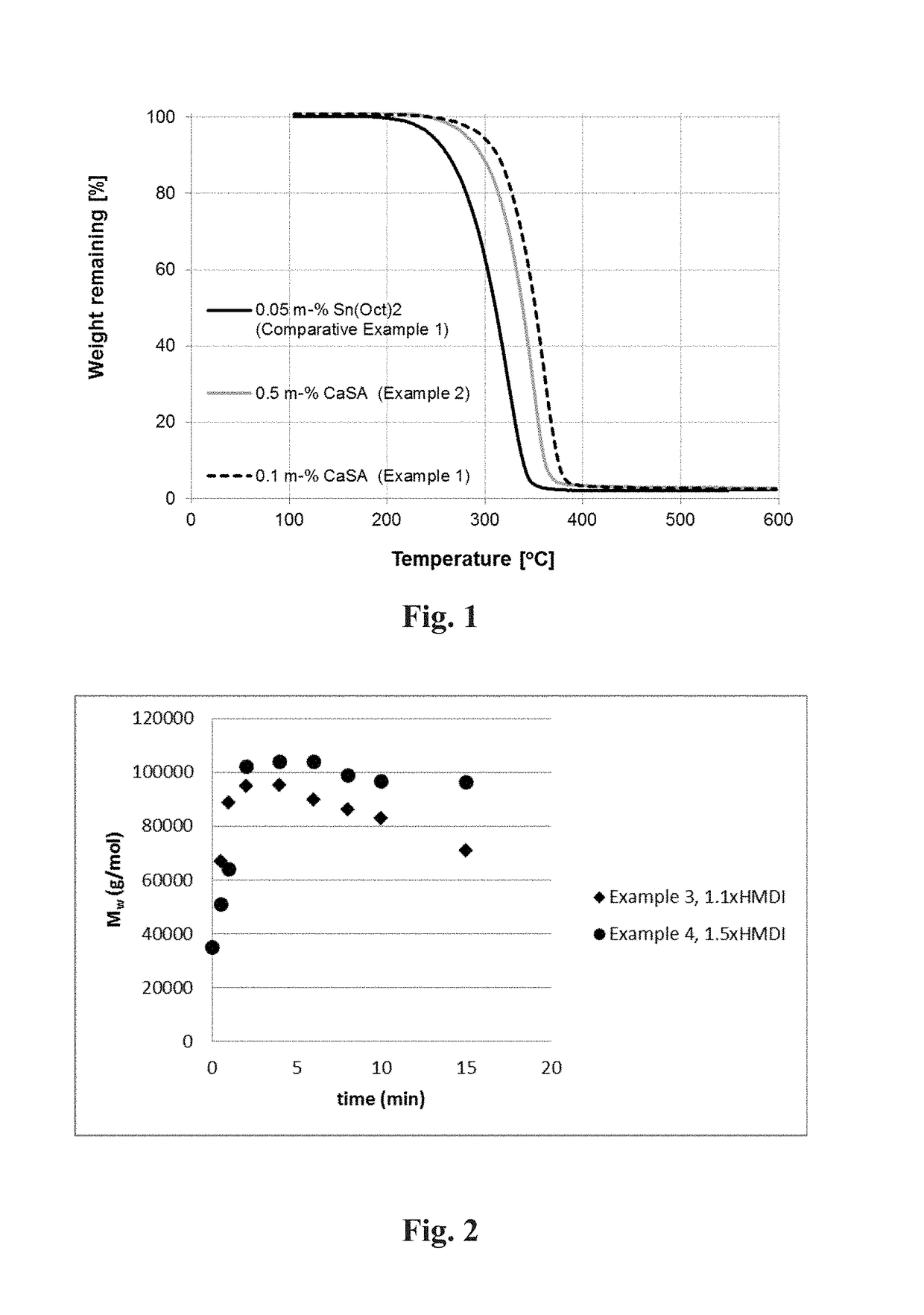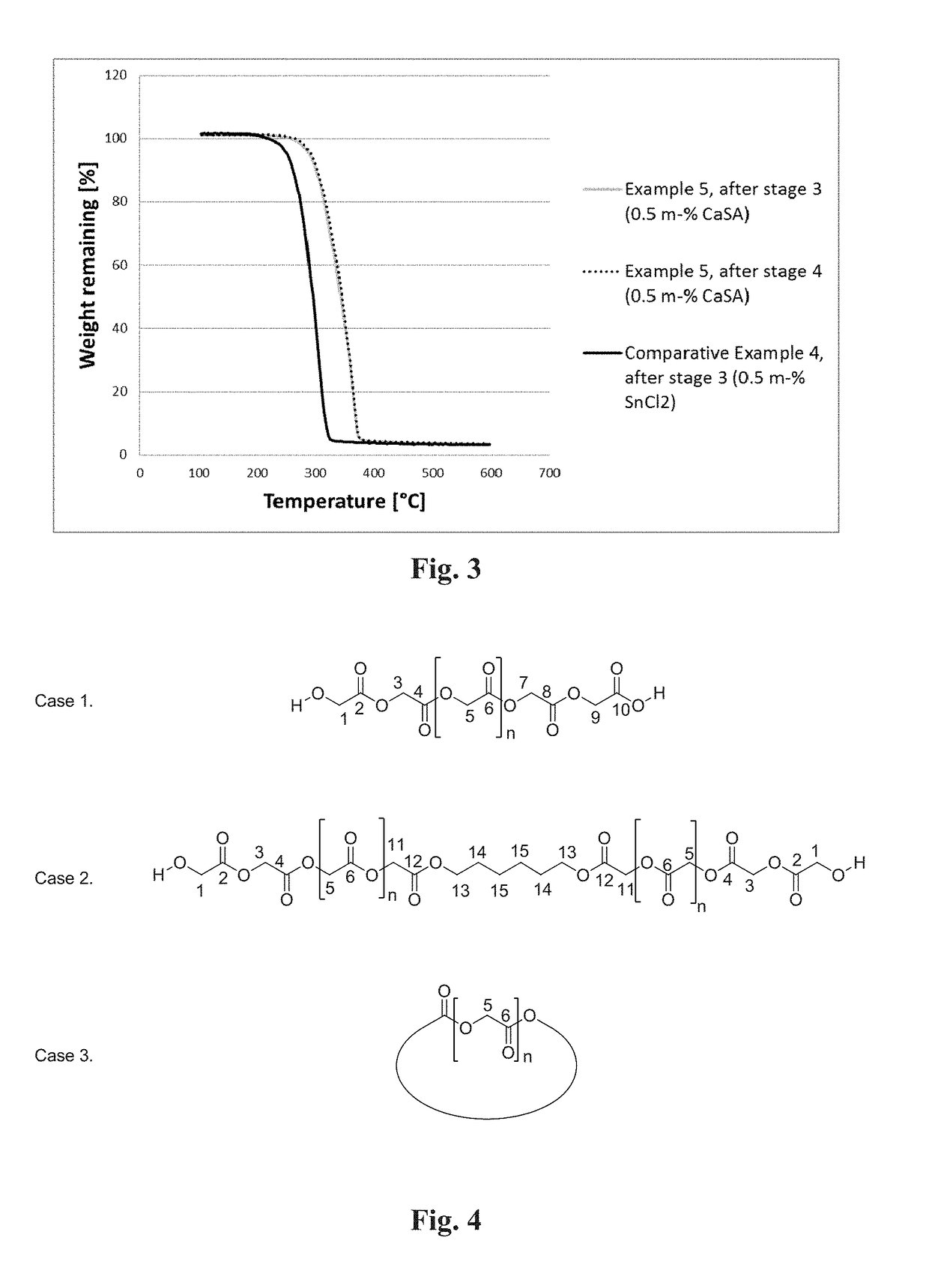Method of producing glycolic acid polymers
a glycolic acid and polymer technology, applied in the field of polymerization, can solve the problems of difficult preparation of pure glycolide which yields high molecular weight polyglycolic acid, loss of desired optical purity of the precursor, and low molar mass of polymer, etc., to achieve excellent thermal stability and reduce the loss of material due to depolymerisation to the corresponding lactone
- Summary
- Abstract
- Description
- Claims
- Application Information
AI Technical Summary
Benefits of technology
Problems solved by technology
Method used
Image
Examples
example 1
[0132]1000 g solid glycolic acid, 31 g hexanediol (2 mol-%) and 1.0 g CaSA (0.1 m-%) were added to a 2000 mL multipurpose reactor equipped with mechanical stirrer. Temperature was increased gradually from 150° C. to 210° C. and pressure was decreased gradually from 1000 mbar to 30 mbar during four hours. The obtained solid was ground to coarse powder. Yield 762 g, Mn (NMR) 1 600 g / mol, Tg=14° C. Tm=206° C. ΔHm=−77.7 J / g, 40% OH-terminated.
[0133]The coarse polymer powder was then placed into a 2000 ml multipurpose reactor with mechanical stirrer. The reaction was continued in solid state at 170° C. and 30 mbar for 24 h. Mn (NMR) 4 100 g / mol, Mn (GPC) 12 700 g / mol, Mw (GPC) 34 900 g / mol, Tg=32° C. Tm=206° C. ΔHm=−74.9 J / g, ca. 100% OH-terminated. Td 10%=304° C., FIG. 1.
example 2
[0134]1000 g solid glycolic acid, 31 g hexanediol (2 mol-%) and 5.2 g CaSA (0.1 m-%) were added to a 2000 mL multipurpose reactor with mechanical stirrer. Temperature was increased gradually from 150° C. to 210° C. and pressure was decreased gradually from 1000 mbar to 30 mbar during four hours. The obtained solid was ground to coarse powder. Yield 760 g, Mn (NMR) 1 500 g / mol, Tg=22° C. Tm=203° C. ΔHm=−78.4 J / g, 51% OH-terminated.
[0135]The coarse polymer powder was then placed into a 2000 ml multipurpose reactor with mechanical stirrer. The reaction was continued in solid state at 170° C. and 30 mbar for 24 h. Mn (NMR) 2 700 g / mol, Tg=26° C. Tm=206° C. ΔHm=−74.2 J / g, 84% OH-terminated. Td 10%=301° C., FIG. 1.
example 3
[0136]40 g of prepolymer prepared in Example 1 and hexamethylene di-isocyanate (HMDI) with a ratio of 1.1 was added to into DIT 2CV mixing equipment at 225° C. under N2. Samples were taken at 0.5, 1, 2, 4, 6, 8, 10 and 15 minutes. Mn (GPC) at 2 min 19 700 g / mol, Mw(GPC) 94 900 g / mol. At 2 min: Tg=32° C. Tm=203° C. ΔHm=−67.3 J / g. The Mw of all the samples are presented in FIG. 2.
PUM
| Property | Measurement | Unit |
|---|---|---|
| boiling point | aaaaa | aaaaa |
| boiling point | aaaaa | aaaaa |
| decomposition temperature | aaaaa | aaaaa |
Abstract
Description
Claims
Application Information
 Login to View More
Login to View More - R&D
- Intellectual Property
- Life Sciences
- Materials
- Tech Scout
- Unparalleled Data Quality
- Higher Quality Content
- 60% Fewer Hallucinations
Browse by: Latest US Patents, China's latest patents, Technical Efficacy Thesaurus, Application Domain, Technology Topic, Popular Technical Reports.
© 2025 PatSnap. All rights reserved.Legal|Privacy policy|Modern Slavery Act Transparency Statement|Sitemap|About US| Contact US: help@patsnap.com



